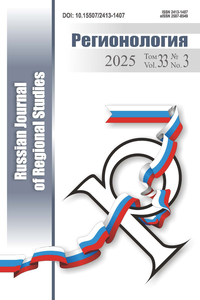A. F. Validova. Impact of the Demographic Policy on Birth Rates in the Russian Federation and the Republic of Tatarstan
UDK 314.145(470+571)
DOI: https://doi.org/10.15507/2413-1407.104.026.201803.494-511
Introduction. The solution to the problem of ensuring demographic growth is one of the most pressing issues of the state policy. In 2007, Russia’s demographic policy was supplemented by new measures to stimulate the birth rate. The objective of this paper is to analyze the effectiveness of the demographic policy programs aimed at supporting families and natality using the case studies of the Russian Federation and the Republic of Tatarstan.
Materials and Methods. To identify the impact of measures to stimulate the birth rate, the method of regression analysis was used; time series based on age-specific birth rates for each age group were presented.
Results. The data obtained showed that the steady trend of increasing the total fertility rate in Russia and Tatarstan since 2007 was almost completely related to the measures under consideration, whereas the number of births was affected by many other factors. According to the results of the study, the impact of measures to increase the birth rate in the Republic of Tatarstan is slightly higher than in Russia as a whole.
Discussion and Conclusions. State support measures reduce the costs associated with the birth of a child and can encourage women to have children, which confirms the hypothesis of the positive impact of the state fertility policy. For a more accurate assessment of the effectiveness of the demographic policy measures, it is advisable to take into account the changing social and economic conditions of life in a region, as well as the consequences of the earlier or present-day demographic policy measures. The results of the study are of practical importance and may be used in the development of demographic policies in the country and in the region.
Keywords: demographic policy, birth rate, reproductive behavior, fertility programs, family policy, demographic analysis of a region
REFERENCES
1.Gauthier A.H., Hatzius J. Family benefits and fertility: An econometric analysis. Population Studies. 1997; 51(3):295-306. Available at: https://www.jstor.org/stable/2952473?seq=1#page_scan_tab_contents (accessed 03.02.2018).
2.Gauthier A.H. The impact of family policies on fertility in industrialized countries: a review of the literature. Population Research and Policy Review. 2007; 26(3):323-346. DOI: https://doi.org/10.1007/s11113-007-9033-x
3.Olivetti C., Petrongolo B. The economic consequences of family policies: Lessons from a century of legislation in high-income countries. Journal of Economic Perspectives, American Economic Association. 2017; 31(1):205-230. DOI: https://doi.org/10.3386/w23051
4.Blanchet D., Ekert-Jaffe O. The demographic impact of fertility benefits: Evidence from a micro-model and from macro-data. The family, the market and the state in ageing societies. 1994. p. 79-104. Available at: https://www.popline.org/node/288863 (accessed 03.02.2018).
5.Zhang J., Quan J., Meerbergen P. van The effect of tax-transfer policies on fertility in Canada, 1921-88. Journal of Human Resources. 1994; 29(1):181-201. DOI: https://doi.org/10.2307/146061
6.McDonald P. Low fertility and the state: The efficacy of policy. Population and Development Review. 2006; 32(3):401-510. DOI: https://doi.org/10.1111/j.1728-4457.2006.00134.x
7.Luci-Greulich A., Thévenon O. Does economic advancement ‘cause’ a re-increase in fertility? An Empirical Analysis for OECD Countries (1960–2007). European Journal of Population. 2014; 13(2):187-221. DOI: https://doi.org/10.1007/s10680-013-9309-2
8.D’Addio A.C., d’Ercole M. Trends and determinants of fertility rates in OECD countries: the role of policies. OECD Social, Employment and Migration Working Papers. 2005; 27. DOI: https://doi.org/10.1787/880242325663
9.Kohler, H.-P., Billari F.B., Ortega J.A. Low fertility in Europe: Causes, implications and policy options. The Baby Bust: Who will do the Work? Who Will Pay the Taxes? 2006. p. 48-109. Available at: http://citeseerx.ist.psu.edu/viewdoc/summary?doi=10.1.1.357.4258 (accessed 03.02.2018).
10.Sobotka T. Tempo-quantum and period-cohort interplay in fertility changes in Europe: Evidence from the Czech Republic, Italy, the Netherlands and Sweden. Demographic Research. 2003; 8:151-214. DOI: https://doi.org/10.4054/DemRes.2003.8.6
11.Sobotka T. Re-emerging diversity: Rapid fertility changes in Central and Eastern Europe after the collapse of the communist regimes. Population. 2003; 58(4/5):451-486. DOI: https://doi.org/10.2307/3246652
12.Frejka T., Gietel-Basten S. Fertility and family policies in central and eastern Europe after 1990. Comparative Population Studies. 2016; 41(1):3-56. DOI: http://dx.doi.org/10.12765/CPoS-2016-03en
13.Frejka T., Zakharov S. The apparent failure of Russia’s pronatalist family policy. Population and Development Review. 2013; 39(4):635-647. DOI: https://doi.org/10.1111/j.1728-4457.2013.00631.x
14.Speder Z., Murinko L., Olah L.Sz. Sailing close to the wind? The effects of third birth policies in post-communist Hungary. Working Papers on Population, Family and Welfare. 2017; 27. Available at: http://demografia.hu/en/publicationsonline/index.php/workingpapers/artic... (accessed 03.02.2018).
15.Mitrofanova E.S. Demographic behavior of Russians: Family in post-soviet period. Ekonomicheskiy zhurnal Vysshej shkoly ekonomiki = Higher School of Economics Economic Journal. 2001; 15(4):519-542. Available at: https://ej.hse.ru/2011-15-4/49834635.html (accessed 03.02.2018). (In Russ.)
16.Zaharov S.V. Goal indicators of demographic policy: Have we chosen the right path?. Zhurnal Novoy ekonomicheskoy assotsiatsii = The Journal of the New Economic Association. 2011; 9:176-180. Available at: http://journal.econorus.org/jarchive.phtml (accessed 03.02.2018). (In Russ.)
17.Zaharov S.V. The modest results of the pronatalist policy against the background of long-term evolution of fertility in Russia. Part 1. Demograficheskoye obozreniye = Demographic Review. 2016; 3(3):6-38. DOI: https://doi.org/10.17323/demreview.v3i3.1745
18.Frejka T., Zakharov S. Comprehensive analyses of fertility trends in the Russian Federation during the past half century. 2012. 27 р. Available at: https://www.demogr.mpg.de/papers/working/wp-2012-027.pdf (accessed 03.02.2018).
Submitted 21.03.2018; accepted for publication 13.06.2018; published online 28.09.2018.
About the author:
Asiya F. Validova, Senior Research Officer, Family and Demography Center, Tatarstan Academy of Science (36a Levobulachnaya St., Kazan 420111, Russia), Ph. D. (Economics), ORCID: https://orcid.org/0000-0001-5227-0940, Scopus ID: https://www.scopus.com/authid/detail.uri?authorId=56150632800, Researcher ID: http://www.researcherid.com/rid/O-3406-2018, avalidova@gmail.com
For citation:
Validova A.F. Impact of the Demographic Policy on Birth Rates in the Russian Federation and the Republic of Tatarstan. Regionologiya = Regionology. 2018; 26(3):494-511. DOI: https://doi.org/10.15507/2413-1407.104.026.201803.494-511
The author has read and approved the final version of the manuscript.

All the materials of the "REGIONOLOGY" journal are available under Creative Commons «Attribution» 4.0
















